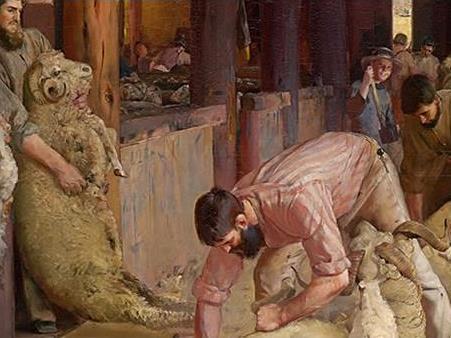Tom Roberts Shearing the rams 1888–90 (detail) National Gallery of Victoria, Melbourne, Felton Bequest Fund, 1932.
Tom Roberts (1856-1931), the artist behind iconic scenes of dappled light and outback heroism, is on show at the National Gallery of Australia – the summer slot for a great Australian artist.
As an avid Impressionist forging a career in the late 19th century, Roberts captured the immense and unrelenting beauty of a strange new land, and by virtue of his timing, captured the burgeoning of a nation.
His most well known paintings – Shearing the rams (1888-1890), A break away! (1891), The Golden Fleece (1894) and Bailed Up (1895) – continue to interest audiences with their lifelike markings and mythical narrative. They also mark a period in which Australia began to construct a national character through its art.
This is the first time Roberts been represented so definitively, with curator Anna Gray securing over 130 works from public and private collections in a bid to rightfully share the breadth and significance of his practice.
Here we see Gray examine Roberts the portraitist, with works such as Portrait of Florence (1898), Madame Hartl (1909-1910) and An Australian native (1888) demonstrating why Roberts was Australia’s leading in the late 19th and early 20th centuries. It is impossible to engage with Roberts’ portraits without being drawn into the emotional wellbeing of his subjects.
Roberts’ work as a portraitist and his study of nationalistic themes led him to a career defining commission, or so he believed, which proved an impossible undertaking that almost finished his career.
On loan for the first time from Parliament House, Opening of the first Parliament of the Commonwealth of Australia (1903) is a huge 3 x 5 meter artwork that hangs gallantly mid show. Stepping into the dark, thoroughfare-like space it occupies is like stepping inside the ceremony itself: rigid and silent.
The gravity of this historic event is present, yet so is the cultural quandary it presents.
If the NGA’s chief aim is to redefine our thinking of Roberts and freshly embed his legacy into younger generations of Australians able to visit then the exhibition succeeds. To understand where Australia sits today, as a nation, is to understand the path on which it has journeyed and our national institutions act as a visual keepsake of this.
However, if the NGA was hoping to break new ground in its approach to addressing the complexity of our national identity, then it falls short. Reference to a fictional ‘Australian psyche’ that cherishes white nationalistic art does the opposite of being inclusive; it risks the perpetuation of ignorance.
For those, like Roberts, who struggle to find their place in this country, being written into the language of everyday history invites belonging, and a shift of perception in the eyes of the young.
Perhaps for Roberts – a lad born in Dorset, England, who came to this country in 1869 at the age of 13 – his fascination with the character of a nation he felt an outside observer of was a way to write himself in.
Tom Roberts
Rating 4.5 out of 5 stars
National Gallery of Australia
Closes March 28, 2016.
$20 adults, $15 NGA members, $17.50 concession/student.





